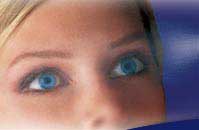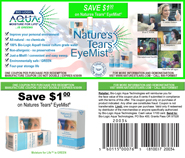
Understanding Eye Hydration
Recent Dry Eye Discoveries Could Save Your Vision…and Life
By Sharon Kleyne, Research Director, Bio-Logic Aqua Research"These new discoveries, for the first time, enable individuals to take control over dehydrated eyes (dry eye) through a simple and safe daily (or even hourly) moisture supplementation regimen."
Summary. The condition may be called "dry eye," "red eye," "eye strain," "allergy eyes," "irritated eyes," "tired eyes," "sore eyes," "itchy eyes," "puffy eyes," or "swollen eyes." Dry eye is experienced by nearly everyone and researchers predict that within 20 years, dehydration related eye diseases could become a global health crisis. Bio-Logic Aqua Research presents this series, "Understanding Eye Hydration," in the belief that correct individual health choices require knowledge that is up-to-date and, where necessary, "outside the box." This initial report summarizes the latest findings on dry eye causes, physiology and treatment.
Eye dehydration and re-hydration.
In recent decades, dehydration related health issues, such as dry eye, dry skin, dry mouth, computer eye irritation, contact lens dryness, allergies, viral and sunburn sensitivity, adult acne, dermatitis, diabetes, Sjogren's syndrome, lupus, scleroderma, and cancers of the skin and eyes, have increased dramatically. These conditions are attributed to multiple factors:
The amazing tear film
Whether eye dehydration is caused by dry air, computers, contact lenses or other factors, symptoms occur because moisture (water) has been lost from the microscopically thin tear film covering the eyes' exposed portions. Though only about 20 to 30 microns (millionths of a meter) thick, the tear film is amazingly complex.
Tear film layers
Lipid layer. This outer layer is a thin film of fatty oils (over 100 different fats and oils have been identified), that lubricate the eyelid and slow moisture evaporation from lower layers. Aqueous layer. The middle and thickest layer contains most of the tear film's moisture (water). It also contains electrolytes, beneficial proteins and enzymes, and bacteria-fighting antibodies. Mucin layer. This bottom layer glues the tear film to the ocular surface.
Why eyes become dehydrated
Dry eye may be experienced as itching, burning, irritation, eyestrain, drowsiness, headache, allergies, and/or a "grainy" sensation. This occurs when moisture (water) is lost from the tear film, causing excessive concentration of the tear film's salt (electrolyte) component. When lost moisture is replaced and salt is diluted, discomfort vanishes. Tear film salt concentration may be compared to a teaspoon of salt in a gallon of water versus a teaspoon of salt in an ounce of water. The former would not make your eyes burn, the latter definitely would.
A novel approach to eye re-hydration
Researchers have long known the simplest and most natural way to soothe dry irritated eyes: simply add two-to-five-billionths of a liter of moisture to the aqueous layer. A commercially viable method of achieving this was discovered in 2002 when Bio-Logic Aqua Research developed the first (and only) system that supplements tear film moisture with an ultra-fine, pH-balanced (<7.0) water mist. Mist droplets penetrate the tear film's outer lipid layer much like vinegar penetrates salad oil: the oils parts, the droplets pass, and the oil closes. This new discovery enables individuals, for the first time, to take personal control over dry eye through a simple and safe daily (or even hourly) regimen of moisture supplementation.
Formulated eye drops
Prior to 2002, the only solution to dry irritated eyes had been formulated eye drops delivered with a dropper. Eye drops can pose several drawbacks: (1) They are artificial chemical formulations, (2) droppers may be difficult to use, unsanitary and even dangerous, (3) droppers insert far too much liquid into the eye, (4) drops are ineffective for many people, and (5) drops lack pure, titratable (minute dosage) water required to replenish a dehydrated tear film.
The best of both worlds.
The primary benefit of formulated eye drops is trapping and sealing existing tear film moisture to slow moisture loss. Drops accomplish this most effectively when the tear film's moisture content is at full capacity. For best results, an ultra-fine, pH balanced water mist should be applied immediately before eye drops. A good eye mist is also beneficial between eye drop applications, or when drops are not convenient.









